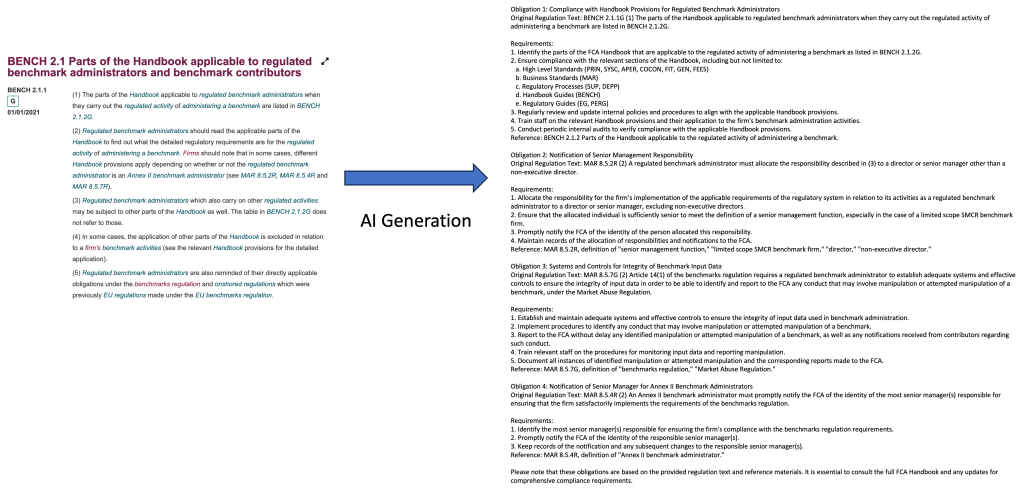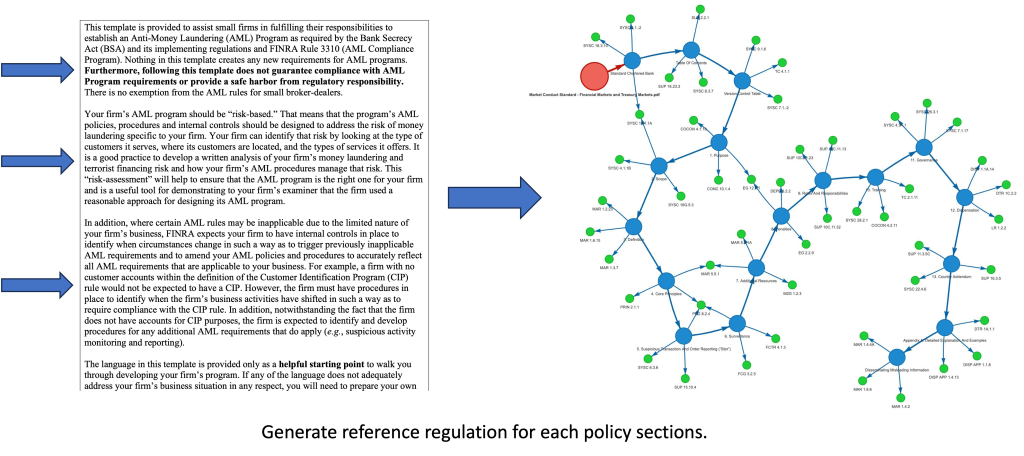AI Regulatory Compliance Officer
An innovative AI-driven solution designed to streamline regulatory compliance. This cutting-edge technology automates the processing of regulatory documents, transforming them into a comprehensive obligation library. By leveraging advanced machine learning algorithms, the solution meticulously analyzes and cross-references these obligations with the company’s internal policies and procedures. Through this thorough gap analysis, it identifies discrepancies and areas of non-compliance, providing actionable insights to bridge these gaps. This ensures that businesses not only adhere to industry standards and regulations but also proactively mitigate compliance risks, thereby enhancing operational efficiency and reducing the potential for regulatory penalties.
Use case 1: Obligation Library Construction
An innovative AI-driven solution designed to streamline regulatory compliance. This cutting-edge technology automates the processing of regulatory documents, transforming them into a comprehensive obligation library. Here’s how it works:
- Decomposition of Provisions: The solution begins by deconstructing complex regulatory texts into multiple discrete obligations. Each provision within the regulatory document is analyzed and broken down into individual, manageable obligations. This decomposition ensures that every regulatory requirement is clearly identified and isolated, facilitating easier management and compliance tracking.
- Self-Contained Obligations: Each obligation generated from the regulatory text is self-contained, meaning it encapsulates all necessary information to understand and fulfill the requirement independently. This approach eliminates ambiguity and provides a clear, actionable directive for compliance teams, ensuring that each obligation is addressed without reliance on external context or additional documentation.
- Cross-Referencing for Obligation Generation: The solution utilizes sophisticated algorithms to cross-reference various sections and clauses of the regulatory text. By doing so, it ensures that all relevant references are included in the obligation generation process. This thorough cross-referencing guarantees that no critical detail is overlooked, and the resulting obligations are comprehensive and fully aligned with the regulatory intent.
Through these steps, the AI-driven solution constructs a detailed and precise obligation library that serves as a cornerstone for compliance management. It allows businesses to systematically compare these obligations with their internal policies and procedures, conducting a thorough gap analysis to identify areas of non-compliance. This process not only ensures adherence to industry standards and regulations but also empowers businesses to proactively address compliance risks, thereby enhancing operational efficiency and reducing the potential for regulatory penalties.

Use case 2: Obligation to Policy Mapping
Our advanced AI system takes the meticulously generated obligations and maps them against the company’s internal policies to ensure compliance. This process involves several critical steps:
- Automated Matching: The AI leverages natural language processing (NLP) and machine learning algorithms to automatically match each obligation with the corresponding internal policy or procedure. This automated matching is highly accurate, minimizing the risk of human error and significantly reducing the time required for manual comparison.
- Contextual Analysis: The system performs a deep contextual analysis to understand the nuances of both the obligations and the internal policies. It ensures that the obligations are not only matched to the most relevant policies but also considers the context in which they are applied, providing a more precise and meaningful alignment.
- Gap Identification: By comparing the obligations with internal policies, the AI system identifies any gaps or discrepancies. It highlights areas where internal policies may fall short of regulatory requirements or where additional policies might be needed. This comprehensive gap analysis helps organizations proactively address potential compliance issues before they escalate.
- Continuous Monitoring and Updates: The obligation to policy mapping is not a one-time process. Our AI system continuously monitors regulatory changes and updates the obligation library accordingly. It then re-evaluates the internal policies against the updated obligations to ensure ongoing compliance, adapting to new regulations and standards as they emerge.
- Actionable Insights: The results of the mapping process are presented in a clear, actionable format. Compliance teams receive detailed reports and dashboards that outline the specific obligations, their corresponding internal policies, and any identified gaps. This enables them to take targeted actions to address compliance issues, update policies, and ensure regulatory adherence.
Through this robust obligation to policy mapping process, our AI system ensures that businesses maintain continuous compliance with industry standards and regulations, enhancing operational efficiency, and mitigating the risk of regulatory penalties.

Use case 3: Policy Reference Search

Our advanced AI algorithm takes each section from the internal company policy and maps it back to the relevant regulations, ensuring comprehensive compliance and regulatory alignment. This process includes several key components:
- Detailed Policy Analysis: The AI algorithm begins by thoroughly analyzing each section of the internal company policy. It parses through the policy text, identifying key phrases, terms, and requirements that are crucial for regulatory compliance.
- Regulation Mapping: Using natural language processing (NLP) and machine learning techniques, the AI maps these policy sections back to the relevant regulatory texts. It searches for exact matches, synonyms, and contextually similar phrases within the regulatory documents to establish a direct link between internal policies and regulatory requirements.
- Cross-Referencing: The system performs extensive cross-referencing to ensure that all applicable regulations are considered. This includes examining different sections and clauses within the regulatory texts to capture every possible regulatory requirement that the internal policies might need to address.
- Accuracy and Consistency Checks: To ensure the highest level of accuracy, the AI algorithm employs multiple checks and balances. It verifies the consistency of the mappings, ensuring that each policy section is correctly aligned with the corresponding regulatory provisions. This reduces the risk of misinterpretation and ensures that no regulatory requirement is overlooked.
- Dynamic Updates: The policy reference search process is dynamic and continuous. As regulations evolve and new guidelines are introduced, the AI algorithm updates the mappings to reflect the latest regulatory landscape. This ensures that internal policies remain up-to-date and aligned with current regulations.
- Comprehensive Reporting: The results of the policy reference search are compiled into detailed reports. These reports provide a clear overview of how each section of the internal policy maps back to specific regulatory requirements. They highlight any areas where policies may need to be adjusted or updated to ensure full compliance.
By utilizing our sophisticated policy reference search, businesses can achieve a higher level of regulatory alignment. This not only ensures that internal policies are tho
